Playful Learning
The game we are going to develope will be used in the gymnastic lessons.

Interesting observations during the Colors Game test in Ceutí with mentally disabled people aged 19-65.
https://vimeo.com/127043339
In the second week of our stay in Spain, we went to a small village called Ceutí to work on our new prototype. The organisation of the Interactivos conference provided us a big workplace in a museum for contemporary art where all the groups could work on their prototypes. We also got a lot of materials and equipment (like a 3D-printer and soldering equipment) to work with, so we could start working right away!
First we started hooking up the arduino’s to the LED light, an on and off switch and preparing a wireless connection with a big red button that we use to start the game. We tried fitting all of this in the headband but we quickly found out that that this wasn’t the best design. One of the Interactivos coaches came up with the idea to 3D-print casings in which all the parts could fit, nice and tightly. This turned out to be a great solution and we proceeded further with this idea. We got help with modeling the 3D models to print and before we knew it we had a very nice looking box for our first prototype. Meanwhile Dennis prepared all the programming and got the bluetooth connection between the bands and the button working. On Thursday we had almost everything up and running, just in time for our first (spanish!) user-test.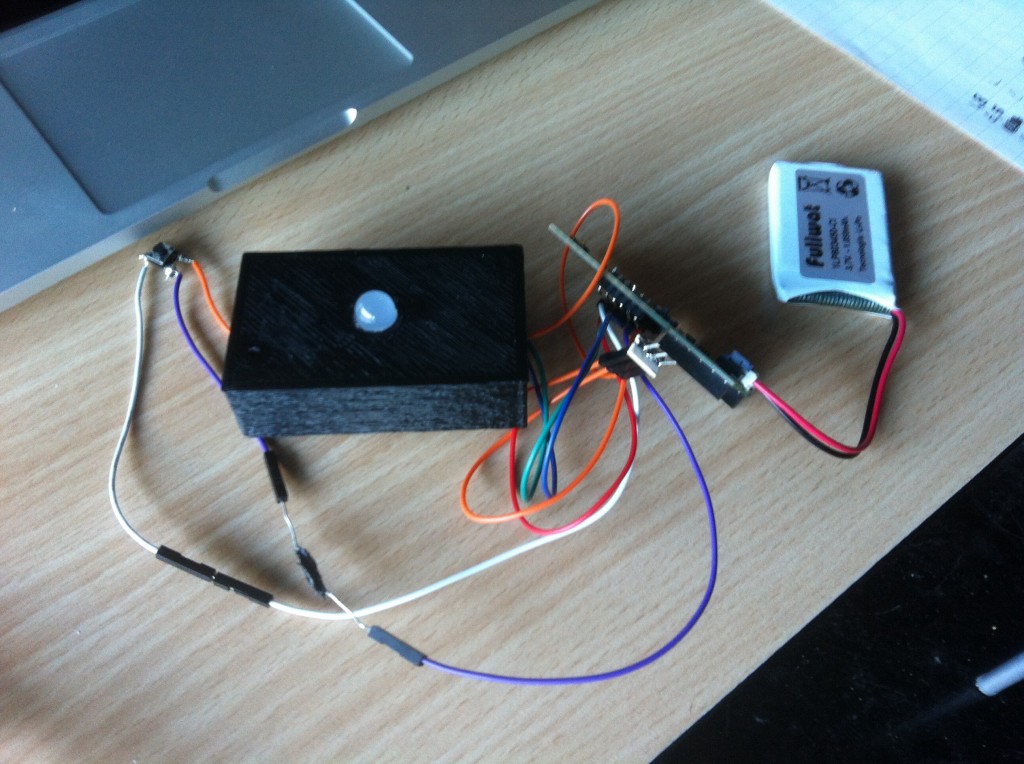
The user-test was with a group of 25 spanish people with similar difficulties as our target group. The only difference was that they were slightly older; between 19 and 63 years old. Nevertheless, the user test went really well. The players understood how the game worked and they were very enthusiastic. Some of the participants were quite creative; for example: they cheated a couple of times by holding their hand close to the LED-light on their head so that they could see the colour of the light reflecting on their hand. Everything went smoother and better than we expected. The headbands worked really well and the group had a lot of fun. At the end of the demonstration we received some useful feedback from the group and their mentors. They had all kinds of ideas how we could improve our game further, to make it more exciting or how to make the instructions clearer.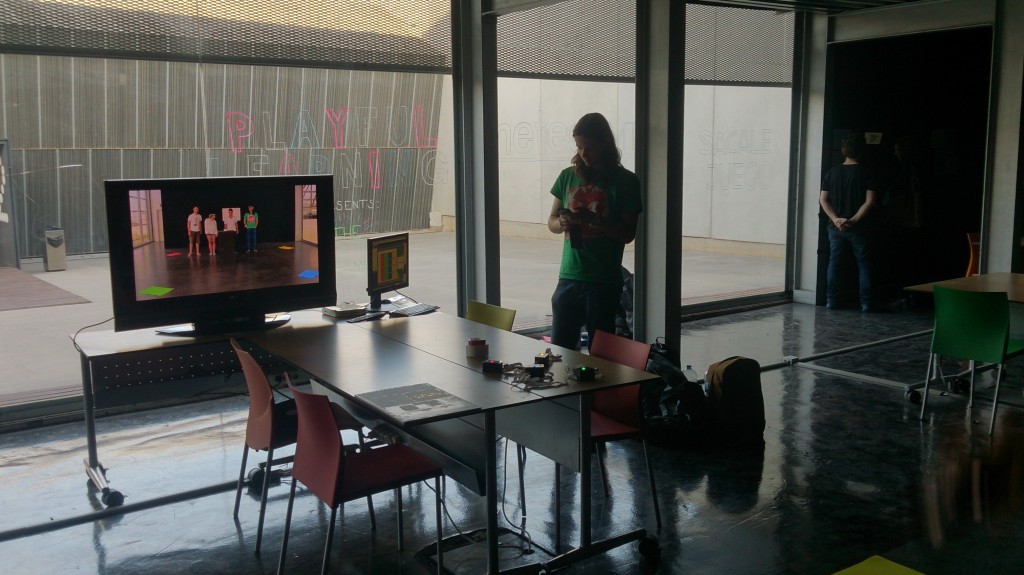
We also made an instruction video (which you can see on our blog!) for our game, to easily explain how the game works. We decided to make it non-verbally and as easy as possible so everyone can understand it. The video was also used at the exhibition, displayed next to our prototype, to present our game. The exhibition was a really open affair where people could walk in an out and look at the different projects that were produced during the ten days before it. Other projects included a new media art project about the weather forecast, with umbrellas and lights that reacted to the weather. A game for children where they had to form the star constellations with each other, which they could see projected on the ceiling. And an app where people could mark fun places in a city via Twitter, to make others aware of them. It was really fun and inspiring to see all the other projects that our spanish colleagues were working on.
All in all we had a great time in Spain. It was sometimes hard work but there was also enough time to have fun (and to try the amazing spanish food!). We are really grateful that we had this amazing opportunity to work with really passionate and talented people, who helped us a great deal with our prototype. These two weeks really took our game to the next level and we’re super proud of the results. Now that we are back in Holland we can start to build further on our prototype to make the best game possible. We’ll keep you posted!
After a short flight we were welcomed by Diego when we arrived at the hotel in Murcia. The first thing we did was checking in at our hotel and we went out for dinner with some spanish people we just met at the hotel. They turned out to be involved in the conference too, so it was nice to meet them in such a short notice.
In the first few days of our trip we were invited to visit the Media, Art and Futures festival in Murcia. This festival was all about new media art and consisted of several presentations, roundtable discussions and a beautiful exhibition. The presentations were very interesting, with topics like: the conservation of new media art and how museums should adapt to them, how new media art can help the development of new innovative techniques and about the funding of media art. We also saw some amazing examples of new media art projects that were really inspiring. However the main language of these presentations was Spanish and we sometimes had a hard time following them. Luckily for us, we were given headsets at most of the presentations, so that we could hear an English translation.
Of course we also had to give a presentations ourselves. Jill and Anne had prepared a very good presentation about our project and we even demonstrated our game on the stage. The girls were kind of nervous beforehand, but they did a really good job and the presentation went very well. The other participants of the Interactivos? workshop also presented their projects and they all were very interesting and diverse. We can’t wait to see how the projects of our spanish colleagues will develop over the next week. The Media, Art and Futures festival ended on friday with a little party, which was a lot of fun and a perfect way to relax a little.
The next morning we left Murcia (slightly hungover) and went to Ceuti, a little village nearby. Here they had a huge center for contemporary art called the Conservatory, where we can work on our new prototype for the next ten days. We get support from some very experienced technicians and programmers and we already received a lot of tools and equipment to start tinkering with. So we’re really excited for the coming week and we can’t wait to show you our new prototype!
To be continued…
Catalogue Of Games
* Football on the Xbox One with Kinect
In this game, two players stand before the motion sensor of the Xbox. The objective is to score goals by passing the ball to teammates. When your striker receives the ball you have to try to shoot the ball on target. The other player is controlling the keeper and has to try to block the opponent’s shot. Both players swap between being on the offence and being the keeper. When the time limit is reached the game is over and the players who scored the most goals wins.
* Skiing on the Nintendo Wii
The purpose of this game is to ski the course as fast as you can. In order to do that you have to stand on the Wii balance board and by shifting your weight you can control the man on the screen.
Variation:
– Place one or two poles alongside the player so that it is easier for him to keep his balance.
* Badminton
Two players stand opposed to each other. They both hold a badminton-racket in their hand. One player serves and both players try to play the shuttle over the net to each other.
Variations:
– The game can also be played with a balloon instead of a shuttle, this makes it easier.
– Badminton can also be played without a net in between, This also makes the game easier.
– To make the game harder, you can play the game while hopping on one leg.
– To make the game more competitive, instead of playing the shuttle or balloon to each other you can implement the scoring of points.
* Basketball
The main goal in this game is to score points by throwing the basketball in the basket. When you score, you have to adjust the scoreboard and you keep possession of the ball. If you miss, the other player has to pick up the basketball and then it’s his turn to try and score. None of the players is allowed to walk when the ball is in their hands.
Variations:
– One player can start with an advantage. For example, one player has to score five points to win and the other player only has to score three points.
– The game can also be played with a volleyball, which is a lighter ball.
* Swing Set
The swing set was an improvised construction. A pair of rings, a wooden stick and a towel wrapped around this wooden stick made this construction well suited for the target group. Students could push each other. The one that was on the swing had to communicate with the ‘pusher’ on how high he/she would swing. On the floor there were mats. When someone wanted to stop swinging he/she would slide his/her feet on the ground till he/she stopped and could get off the swing. Each student would get 2 or 3 minutes on the swing. The students were controlling the stopwatch independent.
* Catapult/slingshot
The students could shoot marbles in hoops (or targets) standing behind benches. If you would hit the target you scored a point. Every player could shoot 3 marbles before handing over the turn to an other student.
Variations:
– The students could help each other reloading and aiming the catapult (this could also be done by the teacher)
*Football
Passing over the ball with the inside side of the foot and also receive and control the ball with the inside of the foot , monkey in the middle and a match at the end.
Variations:
– If passing and receiving the ball with the inside of the foot was too hard, students were also allowed to pass and receive the ball in every way they would like.
* Table tennis
For the students with the highest motoric skills: Play table tennis in the regular way, with a net in the middle of the table but usually without scoring points. Just try to play the ball over the each other as many times as they can is the game.
Variations/adjustments:
– Rolling over the tennis ball without a net in between for the students who found the regular way of playing too hard.
– Add borders to the table, in that way it’s less likely the ball will fall of the table.
– If rolling or playing the ball to each other went well, it was possible to play the game in the normal way.
* Handball
This game was basically played in a 1 vs 1 situation. Both players would have one goal to defend. You could win the game by scoring points and by defending your goal. There was a limitation of distance from where you could try to throw the ball and score.
Variations/adjustments:
– Make the goal of one of the players a little smaller so that it was harder for the other player to score and easier to defend.
– Play the game 2 vs 2.
– Play with a lighter ball.
– Adjust the distance from where the players were allowed to score.
* Tjoepbal
Tjoepbal was played with a ball and a trampoline that was placed against a wall. One of the players would try to throw the ball in such a way on the trampoline so that the other player could catch the ball. When you threw the ball harder on the trampoline the ball would travel a longer distance in the air. This was considered to be fun.
Variations/adjustments
– Try to reach as long of a distance as you can by throwing the ball as hard as you can on the trampoline. (Middle + High level groups)
– Use the wall too, make the game more like squash. The ball was only allowed to bounce one time before it had to be caught. When someone would fail to do that the other player would score a point. (Only the highest level group would play the game like this)
– Only use the wall to bounce the ball against, could also be played by one person. (For the lower levels groups).
* LO-App game
This game was played on the Ipad. The students would play one at a time while other students were watching them, waiting for their turn. The game what was played most of the time was Brickbreaker. The player was able to control a rectangle with his/her body movement and had to break a the bricks with a ball. When someone ‘died’ three times an other student could take his/her place. The students kept score by using three cones.
Variations/adjustments:
– Time limitation instead of three lives.
– Start up an other game where you have to catch bubbles (could also be played by more players at the same time)
After the observations on Thursday 26/3 we made an overview of the natural behavior of the observed groups during games. 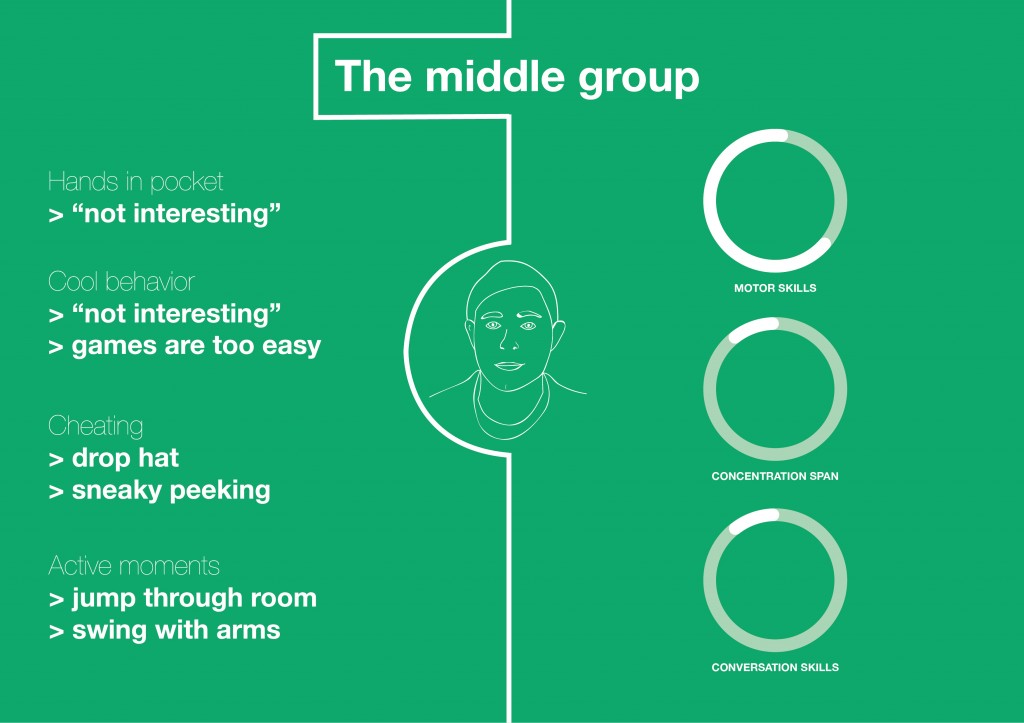
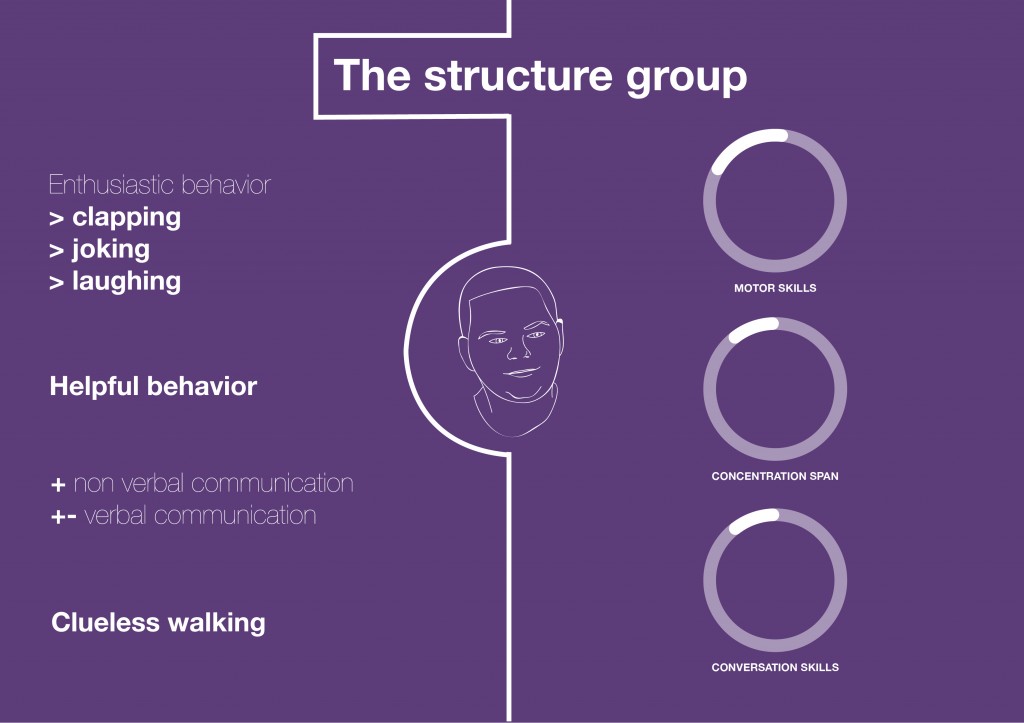
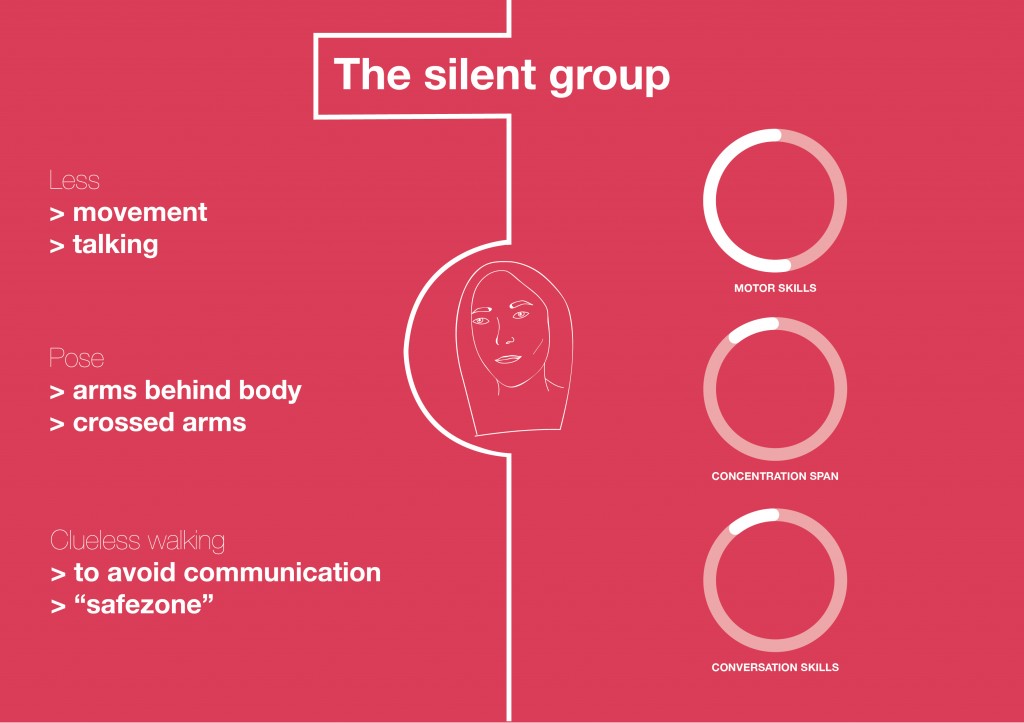
Game: Classroom 2
Today I played the game Classroom 2. This game is about cheating on multiple tests. Your main goal is to do so without the teacher noticing. Together with a few classmates you have to steal exams and sabotage equipment of the teacher. The story where this game is built upon is really entertaining. Even though the graphics aren’t good at all, the game keeps you hooked because of the various levels and the funny storyline. Usually, at least in the beginning stages of the game, the teacher moves around in a certain loop. Because the teachers’ line of sight constantly keeps changing you can take advantage of this by staying out of the line of sight, consult the notes of your comrades and get back in your seat without getting caught.
+ Many levels and clear goals within these levels.
+ Funny sounds when the teacher is talking.
+ Simple game. Not hard to understand.
+ Build-up in difficulty in the game is well done.
– Can be frustrating when you keep getting caught by the teacher. The level isn’t going to get easier, even if you have played that level 100 times.
– In some of the levels you have to move very quick to reach your goal. Sometimes it seems like you just can’t make it and this is very demotivating to play the game.